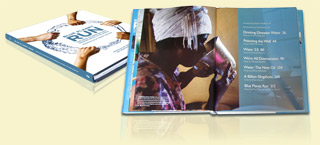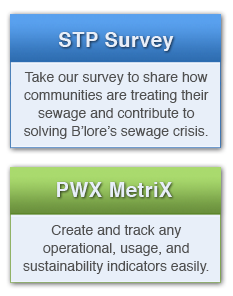The world's water and sanitation crises needs active participation from everybody collaborating together.
It is not going to be solved by governments, NGOs, or the private sector using yesterday's operating model.
PWX is the only combination of people, process, and technology that can address these humanitarian crises.
PWX is scalable and transparent and allows ordinary citizens and groups to easily be part of the local and global effort.
A Reality CheckClick to display
Probably, more than 50% (closer to 80%) of projects conducted around the world fail within a year after 'completion'.
Our friend in Vietnam informed us of the 80+% failure rate of a large international agency's projects.
Another friend made a surprise visit to his projects in Mozambique and found 80% of the ones he visited had failed (or no work had been done).
An Arghyam study documented that 95% of 23,683 school RWH projects in Karnataka, India had never worked.
We estimate that less than 5% of projects get visited after completion and less than 1% get visited long-term.
Given the current philanthropic model, it is hard to get actual facts on long-term success of water projects.
This is what we know for sure:
-
Success of a project cannot be determined at the ribbon-cutting ceremony.
It takes time for people to adopt the technology (including learning to maintain it).
The community takes time to feel true ownership, and it takes longer to change their behavior.
Water projects take time to deliver impact, and determining their sustainability takes even longer.
-
Funding agencies usually close their files after the implementation (ribbon-cutting ceremony) is complete and a report is filed.
-
It is very hard for funding (and many implementing) agencies to visit small projects years
after completion, to see if the equipment is still working, whether it is in use and whether
it has been modified or adapted from the original plan.
-
Current monitoring and evaluation (M&E) activities typically done by researchers and consultants,
involve measuring changes over a wide range of parameters: water quality, health, education, women's status, agriculture, and economic activity.
It is important that projects undergo this time- and resource-intensive analysis, but it is impossible to perform for more than a handful or projects.
-
Only successes are reported, not failures. Projects that are successful and easy to market
(where nice photos and interviews are available) are the only ones that get reported.
We learn best from our mistakes and, unfortunately, it is a hazard to talk about missteps in the philanthropic community,
since the funder and implementer bear the stigma of a failure.
So what is to be done?
The PWX Approach to Verification
PWX is addressing these issues that prevent us from fully understanding the real impact of our current
investment and improve the management and impact of future investments.
First, our peer process does not lay blame, but seeks to learn from failures, which are often
not the doing of the implementer or funder.
In fact, peers learn from others mistakes and appreciate honesty.
Second, we believe that the vast majority of projects can and should be verified by simple steps that can be followed by any visitor:
-
Is the system operating or broken? PWX compares the status reported by the last visitor with the project status reported
by the implementer and raises a flag if they are different.
-
Are people using it? Have they done something different or special with it?
-
Any other observations - visual or through friendly conversations?
-
Photos or video, even using a mobile phone.
We welcome groups and individuals to visit projects,
to learn about our members and their work, take pictures, and talk to people.
Of course, if visitors can sample water quality, we welcome it, but it is not necessary.
For PWX, the projects do not end with the ribbon-cutting ceremony!
Our monitoring features can help track activities and events even on a daily basis.
Our verification program seeks to learn how the people evolve.
We need to know what happens years after the project implementation phase is over.
We want to understand the real long-term impacts of projects. With your help.
Instructions for Helping Verify Project Operations
The more people that visit projects the better!
Use our map, search, or lists, to find a project that you can visit.
Note that GPS coordinates are often approximate and the location/site data is marked as such.
Contact us, if you need help in arranging a visit.
Before the visit, read the application, the Q&A, the project report, and field notes.
Download our android app (for which we are happy to provide a login),
and download project data onto the mobile, especially if you are going offline.
During the visit capture as much data as possible; conduct an interview or two, take pictures and/or video.
After the visit go to the project page and click on "Submit Visitor Note.
Upload the narrative, videos, and photos (the mobile app will upload all data entered automatically).
More detailed instructions are available here.
As we scale up and more projects are managed through our platform finding projects to visit will become easier.
Thank you!
Software Testing
We are constantly enhancing PWX and often use savvy volunteers to test new features and functionality.
Assistance in the Proposal Process
Some of our members seek help with their plans for funding.
It may be translation issues or issues around developing budget spreadsheets or
cropping and uploading pictures.
There are no requests for help currently.
In the future, we hope to be able to allow members to post requests for help on our map and website directly.
Be The Change
Of course, change must begin in our own backyard where we can find ways to conserve water,
avoid polluting downstream, and if possible, recharge and enhance water supply.
There are many sites, books, and a neighbor or two who can provide advice on how to go about doing it.
The book Blue Planet Run,
has many facts about water in a way to help educate and change behavior.
Get it, read it, and get one for a friend.
The design of the PWX office shows the possibilities of saving water, reusing water, and minimizing energy use.


